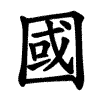國
- country, state;
- nation;
Etymology
The character 國 is derived from 或, which itself is composed of 戈 ("spear," representing weaponry or force) and 口 (representing a walled city or area to be protected).
In bronze inscriptions (金文 jinwen), shapes resembling sticks surrounding the 口 suggest a wall or boundary, which evolved into the horizontal stroke 一 at the lower left of 或. In other words, 或 originally had the meaning of “country.”
Later, when 或 came to mean “perhaps” or “some,” a new character was needed to retain the original sense of “nation.” So, the enclosure radical 囗 was added to clarify the meaning, resulting in 國. The radical 囗 (different from 口) also came to symbolize the territorial boundary of a country. In its standalone form, 囗 is sometimes used as an unofficial abbreviation for 國.
The original pronunciation of 國 was closer to “seong” or “jeong.” The structure symbolized a walled city surrounded by territory, not necessarily a modern nation-state. In ancient times, there was a distinction between:
國 – the governing political center (e.g., a city-state),
邦 – the surrounding territories controlled by that center.
This was similar to the concept of a polis in ancient Greece or Etruria. However, after the founding of the Han dynasty, the use of 邦 declined, partly due to name-avoidance (피휘) for Emperor Liu Bang (劉邦), leading to 國 being used to refer to both the ruling center and its territory — the basis of the modern concept of a state.
This shift also happened in Korea and Japan, where 國 originally meant a small city-state, but as such entities faded, 國 took on the meaning of a territorial nation.
Usage in Korean
國 is commonly used as a prefix to mean “one’s own country.”
For example:
국어 (國語) – "national language" (i.e., Korean)
국사 (國史) – "national history" (i.e., Korean history)
국문학 (國文學) – "national literature"
국악 (國樂) – "Korean traditional music"
Similarly, 국군 (national army) refers to one’s own country’s military. This has also led to slang and compound words like:
국힙 – Korean hip-hop
국맥 – Korean beer
In Taiwan, Guóyǔ (國語) refers to Taiwanese Mandarin.
In Vietnam, Quốc ngữ refers to the Romanized Vietnamese script.
In summary, 國 has evolved from representing a fortified city to embodying the modern state, and its variants reflect a rich history of language, culture, and politics in East Asia.
Words that derived from 國
- 공화국(共和國)–republic
- 국립 공원(國立公園)–national park
- 국무총리(國務總理)–prime minister
- 국민(國民)–people; national; citizen
- 국방(國防)–national defense
- 국방부(國防部)–Ministry of Defense
- 국어(國語)–official language; native language; Korean language
- 국어사전(國語辭典)–Korean dictionary
- 국왕(國王)–king
- 국제(國際)–being international; being global
- 국제연합(國際聯合)–United Nations
- 국토(國土)–national territory
- 국화(國花)–national flower
- 기독왕국(基督王國)–Christian empire
- 남아프리카 공화국(南Africa共和國)–South Africa
- 대한민국(大韓民國)–Republic of Korea
- 도시 국가(都市國家)–city state
- 미국(美國)–the United States
- 애국(愛國)–patriotism
- 약소국(弱小國)–small and weak nation; minor nation
- 영국(英國)–England; the United Kingdom
- 왕국(王國)–kingdom; empire; realm
- 적대국(敵對國)–enemy state
- 전국(全國)–the entire nation
- 제국(帝國)–empire
- 제국주의(帝國主義)–imperialism
- 조국(祖國)–motherland; one's country
- 천국(天國)–heaven
- 천일국(天一國)–Cheon Il Guk
- 한국(韓國)–Korea
- 한국어(韓國語)–Korean; Korean language
- 호국(護國)–national protection; defense of homeland
Alternative forms
囗 (U+56D7) - enclosure radical; component of 國;
囯 (U+56EF) - variant seen in old documents;
国 (U+56FD) - simplified form used in China and Japan, formed with 玉 ("jade") inside 囗;
囶, 囻 - rare variants;
圀 (U+5700) - was used in the Tang dynasty's Zetian character.
Though 囗 looks like 口 ("mouth"), it's larger in size and functions differently; it has largely fallen out of use in modern digital text due to visual similarity.
Interestingly, there also exists an obscure compound character 䆐, which is formed by stacking three 秦 characters and is used to represent a nation in rare cases.
- 田戈口一 (WIRM)
- ⿴ 囗 或
